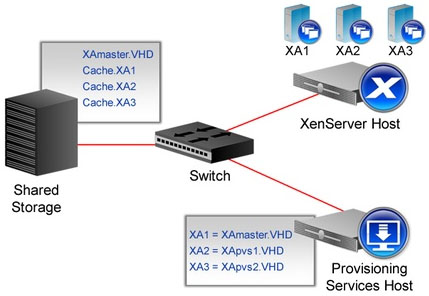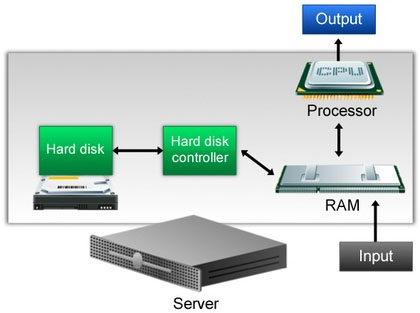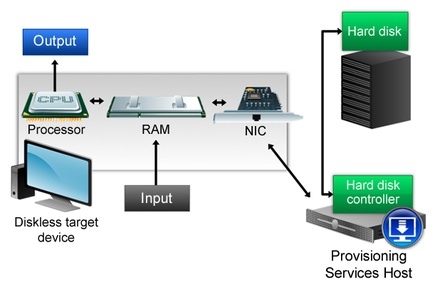Provisioning Services (PVS) provides the capability of having a single master vDisk image that can be delivered to multiple target devices. This eliminates the need to manage and patch individual systems and reduces storage requirements.
The Desktop Delivery Controller (DDC) communicates with the XenServer host to request that certain virtual desktops be turned on or off as they are needed. The DDC and Provisioning Services host communicate to assign groups to vDisk images and to create new assignments based on XenServer templates.
Licenses for the Provisioning Services host are verified by the license server. XenDesktop Enterprise or Platinum licenses must be available in order to use Provisioning Services.
Provisioning Services Architecture - Within the context of a larger end-to-end virtualization solution, Provisioning Services plays a fundamental role central to the standardization of server and desktop images across an organization. In a XenServer-only implementation, virtual disk files for each virtual machine would be stored in a storage location. In large organizations that require a significant number of virtual machines, the cost of storage increases along with the time and resources required to manage the virtual machines.
Provisioning Services complements XenServer by providing a means of simplifying virtual machine management and reducing storage requirements. By using Provisioning Services, you can create a standard virtual machine image that is streamed to server or desktop target devices. The benefit of this configuration is that only one virtual machine hard disk and configuration file must be updated and kept in storage. Resource mappings are stored on a Provisioning Services host and are used to identify which virtual machine images are assigned to each target device. You can easily repurpose workloads by updating a virtual disk mapping and restarting the target device.
Changes that are made while using a Provisioning Services virtual disk can be stored in a cache file. Storing a cache file for each target device that shares a common virtual machine image requires far less storage space than individual virtual machine files in an environment that uses server or desktop provisioning

Traditional Disk Architecture - In traditional disk architecture, input, such as keystrokes or mouse clicks, is passed to the server and is stored in the server RAM. The processor requests instructions from the hard disk controller; these are then passed to the hard disk. The hard disk passes the requested data to the hard disk controller which then passes it back to the RAM. The RAM sends the data and instructions to the processor where it is processed into output that is sent to the end user device in the form of screen updates

Provisioning Services Disk Architecture - In Provisioning Services architecture, input, such as keystrokes or mouse clicks, is passed to the target device and is stored in the server RAM. Unlike traditional disk architecture, the request for instructions from the hard disk is sent to the NIC on the target device. The request is then sent to the hard disk controller, which in this case is the Provisioning Services host. The Provisioning Services host then locates the appropriate hard disk for that target device from a storage device and forwards the data request. The correct data is found on the hard disk, sent back to the Provisioning Services host, and is then sent back to the NIC on the target device. That data is then sent back to the RAM and processed into output in the form of screen updates. Once the reads initiate from the shared disk image, the reads are typically sent from the RAM and cache and do not have to return to the hard disk. This configuration provides additional performance improvements

Provisioning Services Farm Layout - A Provisioning Services farm layout varies based on individual organization requirements. However, a farm always consists of a grouping of Provisioning Services hosts, target devices, and vDisks that are connected to the same database and license server. Provisioning Services hosts communicate with the database constantly to access information that is used to stream vDisks to target devices. The database should be located in physical proximity to the Provisioning Services hosts in the farm to minimize latency and ensure optimal target device performance. The database can be placed anywhere on the network provided that all Provisioning Services hosts can access it. It is possible for Provisioning Services hosts to access a database over a WAN. However, streaming vDisks to target devices requires a robust data link between all Provisioning Services hosts and target devices in a farm, such as a LAN, to ensure optimal performance

License Considerations - Citrix recommends that you upgrade the license server to the latest version when you upgrade or install new Citrix products. New license servers work with previous version of products and license files. New products often require the newest license server to check out licenses correctly. For more information about Citrix licensing, see Citrix article CTX126170
The Desktop Delivery Controller (DDC) communicates with the XenServer host to request that certain virtual desktops be turned on or off as they are needed. The DDC and Provisioning Services host communicate to assign groups to vDisk images and to create new assignments based on XenServer templates.
Licenses for the Provisioning Services host are verified by the license server. XenDesktop Enterprise or Platinum licenses must be available in order to use Provisioning Services.
Provisioning Services Architecture - Within the context of a larger end-to-end virtualization solution, Provisioning Services plays a fundamental role central to the standardization of server and desktop images across an organization. In a XenServer-only implementation, virtual disk files for each virtual machine would be stored in a storage location. In large organizations that require a significant number of virtual machines, the cost of storage increases along with the time and resources required to manage the virtual machines.
Provisioning Services complements XenServer by providing a means of simplifying virtual machine management and reducing storage requirements. By using Provisioning Services, you can create a standard virtual machine image that is streamed to server or desktop target devices. The benefit of this configuration is that only one virtual machine hard disk and configuration file must be updated and kept in storage. Resource mappings are stored on a Provisioning Services host and are used to identify which virtual machine images are assigned to each target device. You can easily repurpose workloads by updating a virtual disk mapping and restarting the target device.
Changes that are made while using a Provisioning Services virtual disk can be stored in a cache file. Storing a cache file for each target device that shares a common virtual machine image requires far less storage space than individual virtual machine files in an environment that uses server or desktop provisioning

Traditional Disk Architecture - In traditional disk architecture, input, such as keystrokes or mouse clicks, is passed to the server and is stored in the server RAM. The processor requests instructions from the hard disk controller; these are then passed to the hard disk. The hard disk passes the requested data to the hard disk controller which then passes it back to the RAM. The RAM sends the data and instructions to the processor where it is processed into output that is sent to the end user device in the form of screen updates

Provisioning Services Disk Architecture - In Provisioning Services architecture, input, such as keystrokes or mouse clicks, is passed to the target device and is stored in the server RAM. Unlike traditional disk architecture, the request for instructions from the hard disk is sent to the NIC on the target device. The request is then sent to the hard disk controller, which in this case is the Provisioning Services host. The Provisioning Services host then locates the appropriate hard disk for that target device from a storage device and forwards the data request. The correct data is found on the hard disk, sent back to the Provisioning Services host, and is then sent back to the NIC on the target device. That data is then sent back to the RAM and processed into output in the form of screen updates. Once the reads initiate from the shared disk image, the reads are typically sent from the RAM and cache and do not have to return to the hard disk. This configuration provides additional performance improvements

Provisioning Services Farm Layout - A Provisioning Services farm layout varies based on individual organization requirements. However, a farm always consists of a grouping of Provisioning Services hosts, target devices, and vDisks that are connected to the same database and license server. Provisioning Services hosts communicate with the database constantly to access information that is used to stream vDisks to target devices. The database should be located in physical proximity to the Provisioning Services hosts in the farm to minimize latency and ensure optimal target device performance. The database can be placed anywhere on the network provided that all Provisioning Services hosts can access it. It is possible for Provisioning Services hosts to access a database over a WAN. However, streaming vDisks to target devices requires a robust data link between all Provisioning Services hosts and target devices in a farm, such as a LAN, to ensure optimal performance

License Considerations - Citrix recommends that you upgrade the license server to the latest version when you upgrade or install new Citrix products. New license servers work with previous version of products and license files. New products often require the newest license server to check out licenses correctly. For more information about Citrix licensing, see Citrix article CTX126170
